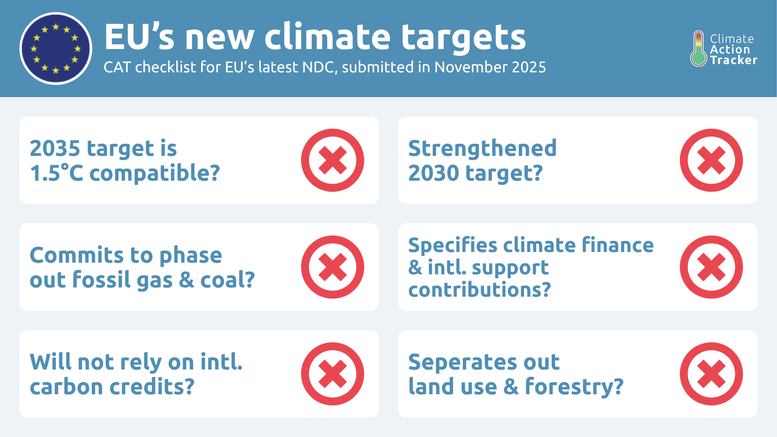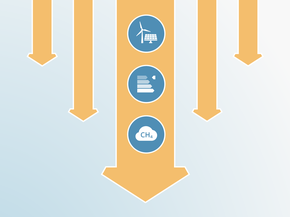2035 NDC
2035 NDC Target
NOTE: We will publish our full analysis here. In the meantime, you can find our fast response below.

Just in time for COP30, the European Union submitted a 2035 NDC target aiming to reduce emissions by 66.25%–72.5% below 1990 levels (incl. LULUCF). This 2035 target range is neither 1.5˚C aligned nor does it meet the EU’s fair share to fight climate change. The less ambitious end of the target would see the EU reduce emissions between 2030-35 at a slower rate than what it has planned between now and 2030.
The Climate Action Tracker finds that to align with 1.5°C compatible modelled domestic pathways, the EU would need to set a 2035 target of at least 77% (incl. LULUCF), alongside a 2040 target of at least 90%, ideally 95% (incl. LULUCF) below 1990 levels, and achieve these reductions within its own borders as recommended by the EU’s own scientific advisory board back in 2023.
Coupled with the 2035 NDC is the 2040 climate target proposal endorsed by EU member states, which has been significantly watered down from the European Commission's original recommendations in February 2024. Instead of a 90% net reduction below 1990 domestically, the 2040 target would now see the EU committing to a net reduction of 85% domestically, with the use of international carbon credits accounting for up to another 5% points of 1990 emissions. This essentially means the EU would be allowing itself to emit 50% more emissions in 2040 by purchasing carbon credits from abroad. The 2040 target still needs to be officially adopted in law following final negotiations between EU institutions.
The EU did not strengthen its 2030 NDC target of 55% reduction below 1990 levels (incl. LULUCF), which is rated ‘Insufficient’ according to the CAT. To be 1.5°C compatible, the EU would need to set an emission reduction target of at least 67% (incl. LULUCF) by 2030.
While the EU maintains a separate LULUCF target of 310 MtCO2 by 2030 (of which 225 MtCO2 can be counted towards the target), it has not provided any LULUCF targets for 2035, nor 2040. The lack of separate LULUCF targets means that it is impossible to know the level to which the EU plans to rely on land sinks, effectively reducing the pressure on member states to reduce emissions across the other sectors of their economies.
In a disappointing break from the EU's current climate laws which require its 2030 target and its 2050 net zero target to be met without offsetting, the EU now intends to achieve its proposed 2040 target (463 MtCO2e incl. LULUCF) with international credits - equivalent to up to 5% of net 1990 levels (231 MtCO2e incl. LULUCF) meaning that domestic reductions would only be 85% below net 1990 levels (694 MtCO2e incl. LULUCF). A domestic 2040 target of 85% (incl. LULUCF) is not 1.5°C compatible compared to modelled domestic pathways.
It is unclear whether the EU would allow the use of international credits to achieve its 2035 target. The EU’s 2040 target proposal would allow a pilot period to initiate an international carbon credit market as early as 2031. The CAT warns that the use of international carbon credits may allow countries to delay or avoid truly ambitious domestic climate action, especially in the absence of clear information on the scale and source of credits to be purchased. This is especially concerning given that even more action is required today, after years of slow progress. The high risks and damages of overshooting 1.5°C have been well established by the scientific community. Policy needs to now focus on limiting both the magnitude and duration of overshoot to bring warming back below 1.5°C before 2100, especially from a developed country region like the EU.
The EU has not committed to phasing out fossil fuels. While it has committed to phasing out fossil gas imports from Russia, it has not committed to phasing out fossil gas – instead, in 2025, signing a EUR 700 billion trade deal with the US to buy energy from the USA, in particular more LNG. Nor has the EU has committed to phasing out coal – instead seeking to only phase down coal and strive to achieve this before 2030. However, several EU member states have phase-out dates for coal beyond 2030 (Germany) or in the case of Poland – have not set a phase-out date.
In addition to opting for weaker targets, the EU has been chipping away at existing climate policies and measures. EU member states have now sought to delay the implementation of the EU ETS II by a year, now set to start from 2028 instead of 2027. Earlier this year the EU Commission also opted to delay the CO2 standards target from 2025 for vehicle manufacturers – now to be achieved by 2027 – which will effectively lead to an additional 26 -51 MtCO2. These amendments, coupled with the watered down 2040 target, continue to delay the pace of emission reductions needed to limit overshooting 1.5°C.
Further analysis
Latest publications
Stay informed
Subscribe to our newsletter




